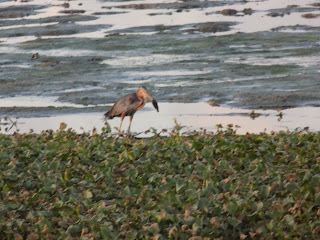Lepidoptera > Papilionoidea > Lycaenidae > Polyommatinae > Polyommatini > Leptotes.
Wetlands are one of the most important freshwater sources. They also provide various ecological services. India is extremely rich in terms of wetland diversity and is one of the few countries in the world to have a wetland inventory system. There are 42 sites in the country that have been designated as Wetlands of International Importance or Ramsar sites. Here we are trying to explore Chennai's Wetland Biodiversity...Anyone can contribute to this...
Leptotes plinius plinius (Fabricius, 1793) – Asian Zebra Blue (வரிக்குதிரை நீலன்) | | Chennai wetland area | Butterflies of Madipakkam & Medavakkam Marshlands, Chennai city wetlands biodiversity
The Purple Heron (Ardea purpurea) செந்நாரை | Chennai wetland area | Birds of Perumbakkam & Medavakkam Marshlands, Chennai city birds
Purple Heron செந்நாரை
Purple heron is one of the most confusing heron, and most similar to the grey heron. There are some noticeable differences which helps in the identification. this birds have been observed at Perumbakkam and Medavakkam wetland areas (we have not visited Pallikaranai marshland).
AARI Quiz on Birds of Chennai Wetlands, May 2021 | Score more than 50% and receive Free Certificate!!!
Annakkili Amma Research Institute (AARI), organizes various quiz and webinar sessions to make the students and researchers engaged in informative and useful activities during this pandemic situation.
we hope this will help you to know about some rare and common birds.
all participants who secure more than a 50% score will receive the printable e-certificate.
Your certificate will be shared via google drive after finishing the quiz kindly check your drive for the certificate if you are not receiving your certificate within 20 mins in your drive that means you failed the Quiz...
If anyone would like to contribute to Chennai Wetland Biodiversity Kindly email, Photographs and Content to chennaiwetlands@gmail.com
This Quiz is closed
The Rose-ringed Parakeet (Psittacula krameri) பச்சைக்கிளி | Chennai wetland area | Birds of Medavakkam Marshlands, Chennai city birds
Scientific classification
Paddyfield Pipit (Anthus rufulus) நெல்வயல் நெட்டைக்காலி Chennai wetland area | Birds of Perumbakkam Marshlands, Chennai city birds
நெல்வயல் நெட்டைக்காலி (paddyfield pipit, அல்லது Oriental pipit, (Anthus rufulus) என்பது ஒரு சிறிய பாசரிபாரம்சு பறவை ஆகும். இது வாலாட்டிக் குருவிக் குடும்பத்தைச் சேர்ந்த பறவை ஆகும். இவை ஒரு பகுதியிலேயே வாழக்கூடியன (வலசை போகாதவை) இவை திறந்த வெளிகளிலும், புல்வெளிகளிலும் வாழக்கூடியன, தெற்கு ஆசியா, கிழக்குப் பிலிப்பீன்சு போன்ற பகுதிகளில் உள்ளன. பிற மற்ற இனங்கள் ஆசியாவின் பிற பகுதியில் காணப்படுகின்றன. ஆசிய பிராந்தியத்தில் குளிர்காலத்தில் இவ்வகைப் பறவைகளை அடையாளம் காண்பது கடினமாக இருக்கும். இனங்களின் வகைப்பாட்டில் சிக்கலான மற்றும் கணிசமான மாற்றங்கள் ஏற்பட்டிருக்கின்றன.
Black Drongo (Dicrurus macrocercus) இரட்டைவால் குருவி
வெண்புருவ வாலாட்டி White-browed Wagtail
Pied Bushchat (Saxicola caprata) புதர்ச்சிட்டு
Purple-rumped Sunbird Leptocoma zeylonica ஊதாப்பிட்டத் தேன்சிட்டு
Eurasian Moorhen Gallinula chloropus தாழைக் கோழி
Bronze winged Jacana (Metopidius indicus) தாமிர இறக்கை இலைக்கோழி
White-breasted waterhen (Amaurornis phoenicurus) வெள்ளை நெஞ்சு நீர்க்கோழி
The greater flamingo (Phoenicopterus roseus) பெரும் பூநாரை
Indian spot-billed duck (Anas poecilorhyncha) புள்ளி மூக்கு வாத்து
The glossy ibis (Plegadis falcinellus) அன்றில் Chennai wetland area | Birds of Medavakkam Marshlands, Chennai city birds
Read More about Glossy ibis here
Black Drongo (Dicrurus macrocercus) இரட்டைவால் குருவி
வெண்புருவ வாலாட்டி White-browed Wagtail
Pied Bushchat (Saxicola caprata) புதர்ச்சிட்டு
Purple-rumped Sunbird Leptocoma zeylonica ஊதாப்பிட்டத் தேன்சிட்டு
Eurasian Moorhen Gallinula chloropus தாழைக் கோழி
Bronze winged Jacana (Metopidius indicus) தாமிர இறக்கை இலைக்கோழி
White-breasted waterhen (Amaurornis phoenicurus) வெள்ளை நெஞ்சு நீர்க்கோழி
The greater flamingo (Phoenicopterus roseus) பெரும் பூநாரை
Indian spot-billed duck (Anas poecilorhyncha) புள்ளி மூக்கு வாத்து
The greater flamingo (Phoenicopterus roseus) பெரும் பூநாரை Chennai Wetland Birds Perumbakkam Marshland birds || Bird watching





AARI World Wetland Day Quiz, 2022 conducted by AARI and Chennai Wetlands Biodiversity Blog || Publish your articles and books with us www.aaribioscience.com
Annakkili Amma Research Institute (AARI) Chennai Wetland Biodiversity Blog wishes you all Happy World Wetland Day 2022 AARI organizes vari...

-
On the mark of World Environment Day (June 5), the World Environment Day Quiz Program conducted AARI and Chennai Wetland Biodiversity blo...
-
Paddyfield pipit Paddyfield pipit at Perumbakkam Marshland area (Photo Credit: U Elaya Perumal) Perumabakkam Marshland has much grasslan...
-
Grey-headed swamphen (Porphyrio poliocephalus) நீலத் தாழைக்கோழி Birds of Chennai Wetland / MarshlandGrey-headed swamphen ( Porphyrio poliocephalus) நீலத் தாழைக்கோழி is a species of swamphen occurring from the Middle East and the Indian su...

























